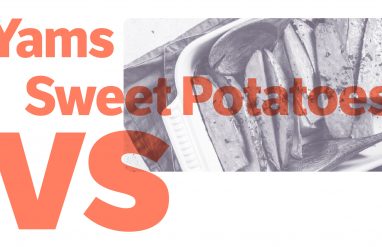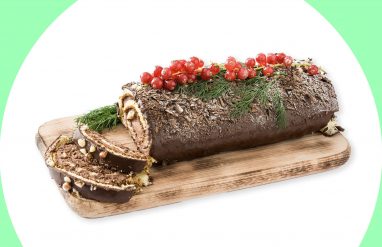It’s the great wedding cake debate: fondant or no fondant? Although some love both the sleek style and firm texture of this thick, sugary topping, others can’t stand it and prefer traditional buttercream, chocolate ganache, or maybe cream cheese. But when it comes to topping an oh-so-perfect cake, there’s another basic question to keep in mind: frosting or icing? And what’s the difference between these two anyway? Are these two distinct types of confectionary toppings, like fondant, or are they synonyms that refer to the same type of sugary goodness? Let’s take a closer look.
What is frosting?
When it comes to food, frosting is a noun that’s defined as “a sweet mixture, cooked or uncooked, for coating or filling cakes, cookies, and the like.” For example:
- The best part of her grandma’s homemade birthday cake is the cream cheese frosting that covers it.
- “Funfetti” cupcakes simply aren’t the same without vanilla frosting complete with rainbow sprinkles.
However, frosting has other meanings, aside from this sugary confection. Frosting can also refer to “a dull or lusterless finish,” as on metal and glass, or “a material used for decorative work, as signs, displays, made from coarse flakes of powdered glass.” Lastly frosting can also mean the process of “highlighting hair by bleaching selected strands.”
In terms of baking, there are several main categories of dessert toppings: buttercream frosting, cooked frosting, whipped cream frosting, ganaches, royal icing, and glazes. Some of these are considered frosting, while others are icings (more on that in a moment). Generally speaking, frosting has a buttery base and is typically that main smooth layer that can come in different flavors to complement the baked good underneath. The ingredients for frosting can range depending on the flavor and type of frosting being made. They can include butter, eggs, sugar, and milk.
The word frosting was first recorded in English sometime around 1610–20. It combines frost (from the Old English frost) and the suffix –ing
What is icing?
Like frosting, icing is a noun that in terms of food refers to a “sweet, creamy spread, as of confectioners’ sugar, butter, and flavoring, for covering cakes, cookies, etc.” For example:
- The kids love decorating our holiday cookies with icings of all colors.
- The baker drizzled icing all over the cinnamon rolls while they were warm.
In meteorology, icing refers to “a coating of ice on a solid object.” And when it comes to aviation, icing means “the freezing of atmospheric moisture on the surface of an aircraft.” Lastly, icing has a distinct meaning when it comes to ice hockey related to a defensive maneuver to keep the puck out of the reach of attacking opponents.
In baking, icing is a sugary base usually used for decorating and adding ornamental details to a dessert. It is typically made from mixing confectioners’ sugar with a liquid, creating a smooth consistency “that’s thick enough to coat the surface of a cookie but thin enough to spread into a completely smooth, almost puddle-like layer,” according to MarthaStewart.com.
Frosting has a more buttery consistency than icing and as TheDailyMeal.com explains, “icing is often used to glaze pastries or cakes, and tastes more sugary than frosting.” Typically, when you think of the shiny, smooth, glossy texture and finish of a glaze, it’s icing that you’re thinking of.
Icing is a slightly newer term and was first recorded around 1760–70. It combines ice (from the Old English ?s) and the suffix –ing.
Oops! We could not locate your form.
How to use icing and frosting
While many people effectively use frosting and icing as synonyms, a lot of bakers make a distinction between the two. Also, frosting is generally favored in the US, while icing is more frequently used in British English.
Bakers will say that the two main differences between frosting and icing are where it is being used and the texture. “In broad terms, frosting is thick and fluffy, and is used to coat the outside (and often the inner layers) of a cake,” explains MarthaStewart.com. “Icing is thinner and glossier than frosting, and can be used as a glaze or for detailed decorating.”
Williams-Sonoma’s cookbook Cake agrees with these distinctions, explaining “icing is generally thinner and glossier,” while frosting is “a thick, fluffy mixture, used to coat the outside of a cake.”
Generally, frosting is used at least as the topping for traditional cakes and cupcakes, while its thinner counterpart, icing, is often used on cookies, donuts, and cinnamon rolls. For example:
- When my daughter was little, she ate the frosting on a cupcake and ignored the cake. (Here, the frosting is a thick layer on top of a cupcake.)
- That icing is perfectly runny and ready to use to decorate the cookies. (The icing is a thin coating for cookies.)
There’s one more use of icing we haven’t discussed: the idiom icing on the cake. This expression refers to the added benefit of something that’s already good. For example:
- The icing on the cake is that the pay increase comes with a promotion to a new role with a lighter workload.
- Not only did he get into his dream school, but the icing on the cake is he’ll only pay in-state tuition.
If you’re only familiar with the phrase icing on the cake, and not its counterpart frosting on the cake, that’s because the former is the more popular of the two these days. But both versions do exist and date back to the late 1800s and early 1900s.
So the next time you read a dessert menu and are tempted by treats with indulgent icings and decadent frostings, you’ll know that—while there may be a difference to a baker—these two terms both mean yummy to your tummy.














